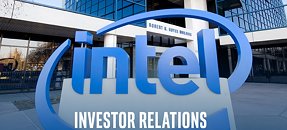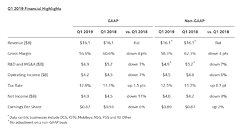Raevenlord
News Editor
- Joined
- Aug 12, 2016
- Messages
- 3,755 (1.15/day)
- Location
- Portugal
| System Name | The Ryzening |
|---|---|
| Processor | AMD Ryzen 9 5900X |
| Motherboard | MSI X570 MAG TOMAHAWK |
| Cooling | Lian Li Galahad 360mm AIO |
| Memory | 32 GB G.Skill Trident Z F4-3733 (4x 8 GB) |
| Video Card(s) | Gigabyte RTX 3070 Ti |
| Storage | Boot: Transcend MTE220S 2TB, Kintson A2000 1TB, Seagate Firewolf Pro 14 TB |
| Display(s) | Acer Nitro VG270UP (1440p 144 Hz IPS) |
| Case | Lian Li O11DX Dynamic White |
| Audio Device(s) | iFi Audio Zen DAC |
| Power Supply | Seasonic Focus+ 750 W |
| Mouse | Cooler Master Masterkeys Lite L |
| Keyboard | Cooler Master Masterkeys Lite L |
| Software | Windows 10 x64 |
Intel Corporation today reported first-quarter 2019 financial results. In the first quarter, the company generated approximately $5.0 billion in cash from operations, paid dividends of $1.4 billion and used $2.5 billion to repurchase 49 million shares of stock.
"Results for the first quarter were slightly higher than our January expectations. We shipped a strong mix of high-performance products and continued spending discipline while ramping 10nm and managing a challenging NAND pricing environment. Looking ahead, we're taking a more cautious view of the year, although we expect market conditions to improve in the second half," said Bob Swan, Intel CEO. "Our team is focused on expanding our market opportunity, accelerating our innovation and improving execution while evolving our culture. We aim to capitalize on key technology inflections that set us up to play a larger role in our customers' success, while improving returns for our owners."


Highlights:
In the first quarter, Intel achieved 4 percent growth in the PC-centric business while data-centric revenue declined 5 percent.

The PC-centric business (CCG) was up 4 percent in the first quarter due to a strong mix of Intel's higher performance products and strength in gaming, large commercial and modem. Intel's first high-volume 10nm processor, code-named Ice Lake, remains on track to be in volume systems on retail shelves for the 2019 holiday selling season.
Collectively, Intel's data-centric businesses declined 5 percent YoY in the first quarter. In the Data Center Group (DCG), the cloud segment grew 5 percent while the communications service provider segment declined 4 percent and enterprise and government revenue declined 21 percent. First-quarter Internet of Things Group (IOTG) revenue grew 8 percent YoY (19 percent excluding Wind River1), and Mobileye achieved record first-quarter revenue of $209 million, up 38 percent YoY as customer momentum continued. Intel's memory business (NSG) was down 12 percent YoY in a challenging pricing environment. Intel's Programmable Solutions Group (PSG) revenue was down 2 percent YoY in the first quarter.
The first quarter marked the introduction of a broad, new portfolio of data-centric products from Intel featuring the 2nd-Generation Intel Xeon Scalable processor family with integrated Intel Deep Learning Boost (Intel DL Boost) for AI deep learning inferencing acceleration and support for Intel Optane DC persistent memory, the revolutionary technology that brings affordable, high-capacity persistent memory to Intel's data-centric computing portfolio. Intel also introduced more than 50 workload-optimized Intel Xeon processors, a 56-core, 12 memory channel Intel Xeon Platinum 9200 processor, and the new Intel Agilex line of 10nm-based FPGAs.
View at TechPowerUp Main Site
"Results for the first quarter were slightly higher than our January expectations. We shipped a strong mix of high-performance products and continued spending discipline while ramping 10nm and managing a challenging NAND pricing environment. Looking ahead, we're taking a more cautious view of the year, although we expect market conditions to improve in the second half," said Bob Swan, Intel CEO. "Our team is focused on expanding our market opportunity, accelerating our innovation and improving execution while evolving our culture. We aim to capitalize on key technology inflections that set us up to play a larger role in our customers' success, while improving returns for our owners."


Highlights:
- First-quarter revenue was $16.1 billion, flat year-over-year (YoY); data-centric revenue declined 5 percent and PC-centric revenue grew 4 percent.
- First-quarter GAAP earnings-per-share (EPS) of $0.87 declined 6 percent YoY; non-GAAP EPS of $0.89 was up 2 percent.
- Expecting second-quarter revenue of $15.6 billion; second-quarter GAAP EPS of $0.83 and non-GAAP EPS of $0.89.
- Expecting full-year revenue of $69.0 billion, full-year GAAP EPS of $4.14 and non-GAAP EPS of $4.35; down from January guidance.
In the first quarter, Intel achieved 4 percent growth in the PC-centric business while data-centric revenue declined 5 percent.

The PC-centric business (CCG) was up 4 percent in the first quarter due to a strong mix of Intel's higher performance products and strength in gaming, large commercial and modem. Intel's first high-volume 10nm processor, code-named Ice Lake, remains on track to be in volume systems on retail shelves for the 2019 holiday selling season.
Collectively, Intel's data-centric businesses declined 5 percent YoY in the first quarter. In the Data Center Group (DCG), the cloud segment grew 5 percent while the communications service provider segment declined 4 percent and enterprise and government revenue declined 21 percent. First-quarter Internet of Things Group (IOTG) revenue grew 8 percent YoY (19 percent excluding Wind River1), and Mobileye achieved record first-quarter revenue of $209 million, up 38 percent YoY as customer momentum continued. Intel's memory business (NSG) was down 12 percent YoY in a challenging pricing environment. Intel's Programmable Solutions Group (PSG) revenue was down 2 percent YoY in the first quarter.
The first quarter marked the introduction of a broad, new portfolio of data-centric products from Intel featuring the 2nd-Generation Intel Xeon Scalable processor family with integrated Intel Deep Learning Boost (Intel DL Boost) for AI deep learning inferencing acceleration and support for Intel Optane DC persistent memory, the revolutionary technology that brings affordable, high-capacity persistent memory to Intel's data-centric computing portfolio. Intel also introduced more than 50 workload-optimized Intel Xeon processors, a 56-core, 12 memory channel Intel Xeon Platinum 9200 processor, and the new Intel Agilex line of 10nm-based FPGAs.
View at TechPowerUp Main Site

